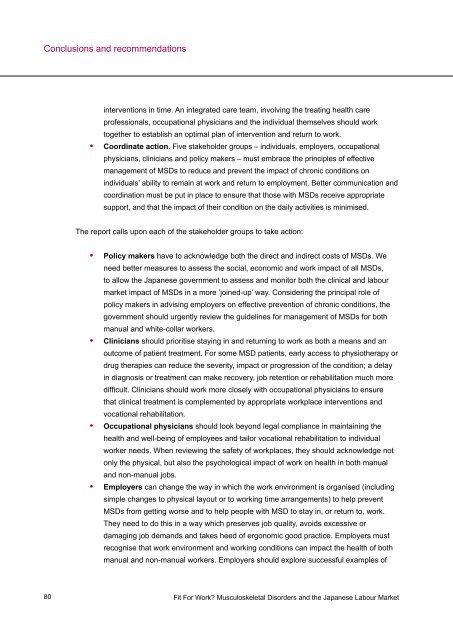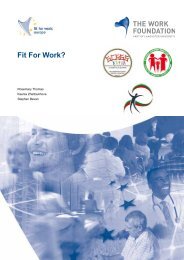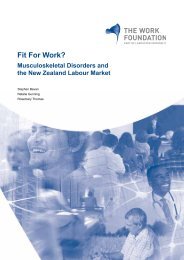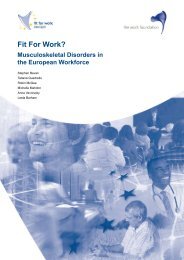English version - Fit for Work Europe
English version - Fit for Work Europe
English version - Fit for Work Europe
Create successful ePaper yourself
Turn your PDF publications into a flip-book with our unique Google optimized e-Paper software.
Conclusions and recommendations<br />
80<br />
interventions in time. An integrated care team, involving the treating health care<br />
professionals, occupational physicians and the individual themselves should work<br />
together to establish an optimal plan of intervention and return to work.<br />
• Coordinate action. Five stakeholder groups – individuals, employers, occupational<br />
physicians, clinicians and policy makers – must embrace the principles of effective<br />
management of MSDs to reduce and prevent the impact of chronic conditions on<br />
individuals’ ability to remain at work and return to employment. Better communication and<br />
coordination must be put in place to ensure that those with MSDs receive appropriate<br />
support, and that the impact of their condition on the daily activities is minimised.<br />
The report calls upon each of the stakeholder groups to take action:<br />
• Policy makers have to acknowledge both the direct and indirect costs of MSDs. We<br />
need better measures to assess the social, economic and work impact of all MSDs,<br />
to allow the Japanese government to assess and monitor both the clinical and labour<br />
market impact of MSDs in a more ‘joined-up’ way. Considering the principal role of<br />
policy makers in advising employers on effective prevention of chronic conditions, the<br />
government should urgently review the guidelines <strong>for</strong> management of MSDs <strong>for</strong> both<br />
manual and white-collar workers.<br />
• Clinicians should prioritise staying in and returning to work as both a means and an<br />
outcome of patient treatment. For some MSD patients, early access to physiotherapy or<br />
drug therapies can reduce the severity, impact or progression of the condition; a delay<br />
in diagnosis or treatment can make recovery, job retention or rehabilitation much more<br />
difficult. Clinicians should work more closely with occupational physicians to ensure<br />
that clinical treatment is complemented by appropriate workplace interventions and<br />
vocational rehabilitation.<br />
• Occupational physicians should look beyond legal compliance in maintaining the<br />
health and well-being of employees and tailor vocational rehabilitation to individual<br />
worker needs. When reviewing the safety of workplaces, they should acknowledge not<br />
only the physical, but also the psychological impact of work on health in both manual<br />
and non-manual jobs.<br />
• Employers can change the way in which the work environment is organised (including<br />
simple changes to physical layout or to working time arrangements) to help prevent<br />
MSDs from getting worse and to help people with MSD to stay in, or return to, work.<br />
They need to do this in a way which preserves job quality, avoids excessive or<br />
damaging job demands and takes heed of ergonomic good practice. Employers must<br />
recognise that work environment and working conditions can impact the health of both<br />
manual and non-manual workers. Employers should explore successful examples of<br />
<strong>Fit</strong> For <strong>Work</strong>? Musculoskeletal Disorders and the Japanese Labour Market







